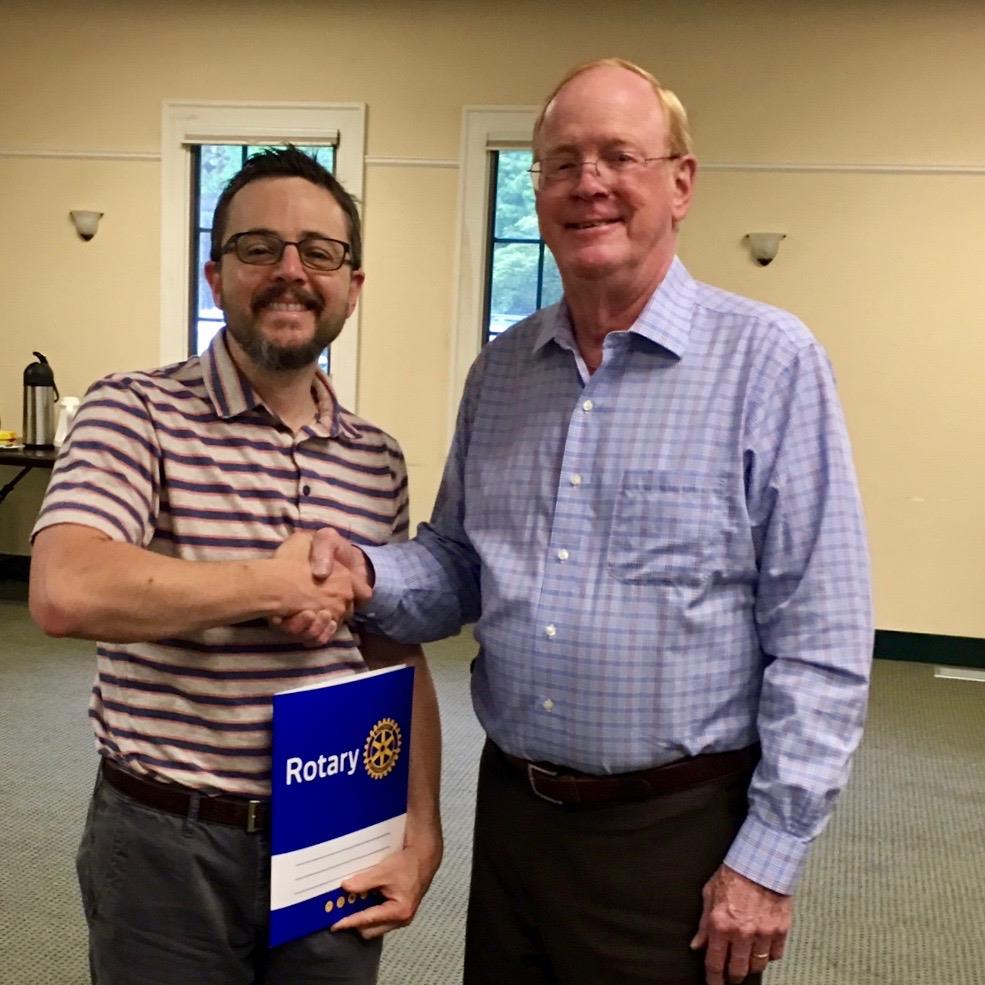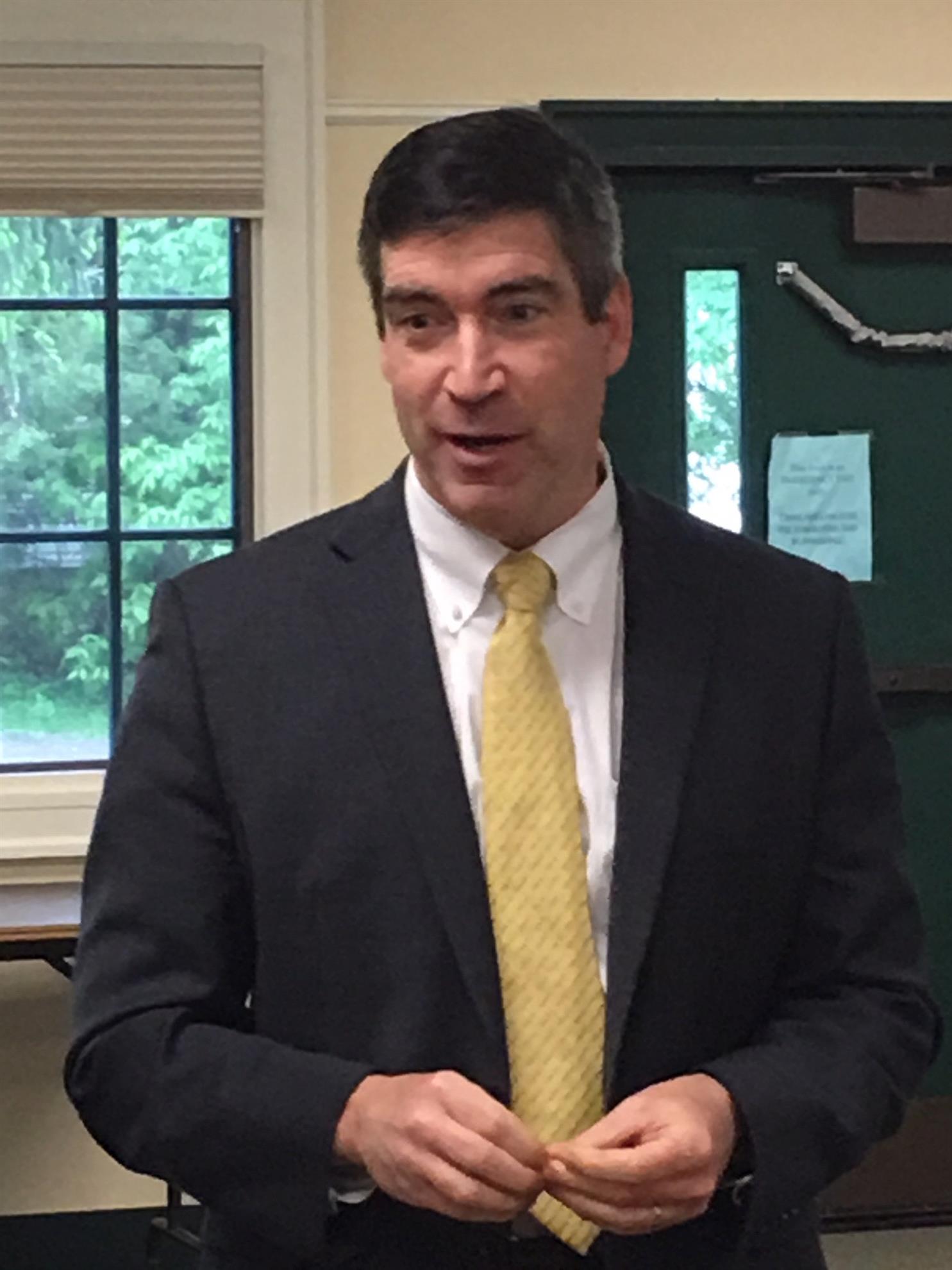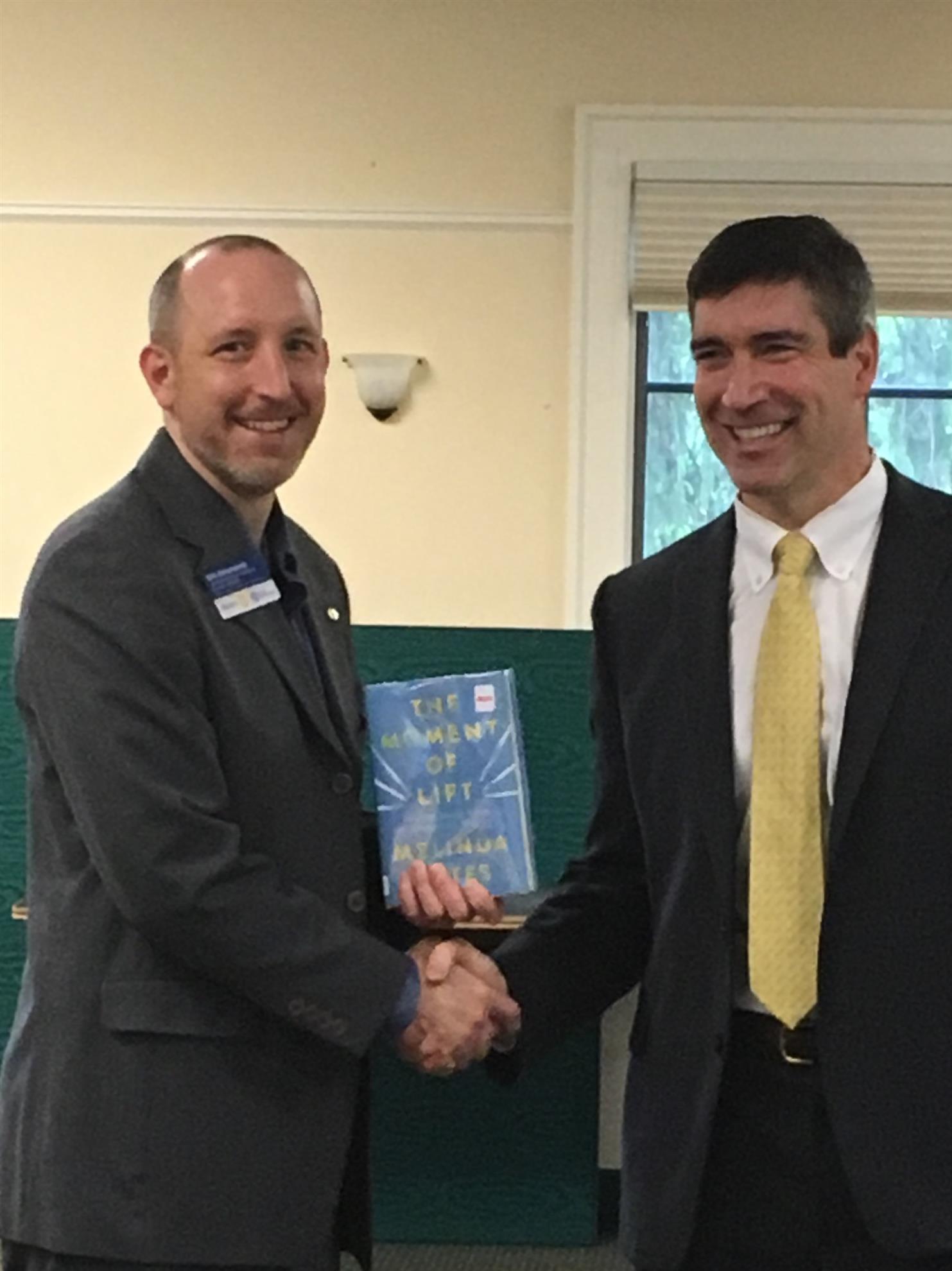


Trinity Community Room
President Erik Kolomaznik called the meeting to order and led the Pledge of Allegiance
Susan Grimes read a devotional by Theodore Roosevelt
Visitors Bud Ockert, Carol Gesche, Matt Segal, Annette Hanna
Customary recitation of the 4 Way Test.
John Lowell shared why joined Rotary. Using Linda’s motto from last week, John’s father was the part of the Lion’s club in the ADK. John settled into practice in Malone, NY and joined the Kiwanis Club. After retirement he met George and was invited to attend a CSH Rotary meeting or two and subsequently joined. He learned about H2HT and was very interested in that. He’s progressively become more involved- parking cars for events, volunteering at the ball drop and playing on the golf team. He’s enjoyed the fellowship, service, projects and community. Chris Davis will share his reasons for joining Rotary next week.
June 5 Cub Scouts and scholarship winners.
June 12 is a club meeting.
Sam reported that the Memorial Day ceremony was a wonderful success. Bud joined us to thank the Rotary for its support of the Veterans Memorial Committee. He said it was a pleasure to be there and to give the presentation together. Bud was in Vietnam and thought he didn’t want to talk about it, but as he got deeper into his Memorial Day presentation he realized he did want to talk about it. He didn’t “wander around the bush” as a soldier, but as an EO in a hospital, he saw about 98% of the casualties. He can still see the 19 yo shot in the head by a sniper that he sat next to in a helicopter. CSH Rotary’s name is on the bench so please come and enjoy it.
Ric Flood reported on the car raffle, which has been rescheduled October 11 at the Coach Barn. There are still 7 tickets left to sell. Margo is still selling tickets! With 27 Tulip tickets sold, (4 during the meeting) we were able to draw a Tulip ticket winner. Kathy Lardman is the lucky winner!
Matt Segal was inducted into Rotary today. Matt grew up in Wisconsin, moved to Charlotte about 15 years ago and works as an accountant in Colchester. His boss is a Rotarian and he encourages his staff to serve. He came to faith a few years ago and decided to come to a Rotary meeting. He found the meetings uplifting and thanks everyone for being so friendly and welcoming.
Community service projects- June 22, race and water station. See Keith.
Help is needed for the farmer’s market at the administration tent helping vendors- see Tod to sign up.
Sergeant at Arms- happy fines- John Dupee
- Linda: happy birthday to Margo
- Lots of folks happy to be here
- Linda G: fulfilled all the paperwork for a class action suit received a check for $100 for H2HT
- Margo: going to the Cape to see the work her sister has done as an Americorps Vista
- Carol: happy her daughter is fine after going into anaphylaxis after being stung by a bee
- Susan ran a half marathon!
- Fritz Horton is celebrating his 75th birthday "How did it get so late so soon?” (Dr. Seuss)
Jessica Brumstead introduced Stephen Leffler, President and Chief Medical Officer of the UVM Medical Center
Jessica has known Steve since he ran the Emergency Room and Jessica started a program called Community Rounds, which brought policy makers into health centers to see first hand how decisions are made. Steve got really involved in the program and helped foster relationships and partnerships between the community and health care providers. Dr. Leffler was formerly the Division of the UVM medical center emergency room. He still takes shifts in the emergency room- typically choosing the hardest shifts so he can stay connected to the division and the community.
Dr. Leffler grew up in Leicester, VT. His parents owned the town general store, which they sold when his youngest brother went to college. Stephen and his two brothers worked in the store growing up, but none of them chose to return to run the store after college.
Stephen attended UVM, and planned to be a wildlife biologist. He then found there were no jobs for wildlife biologist.
He shadowed a friend’s brother who moved back to be a primary care provider and fell in love with the work.
After college he married a woman he’d known since the second grade- they have been married 30 years and recently celebrated their anniversary.
He completed his residency in New Mexico in a big city ER. Stabbings, shootings, overdoses were nightly occurrences.
After completing his residency, He brought his family back to Vermont- he assumed he had given his last dose of Narcan, but unfortunately that was not to be the case.
For his first 10 years he saw no OD’s; then docs started prescribing more opiates. The overarching policy dictated that no patient should have pain. Docs were releasing people who didn’t have a pain score of 0 and that was a problem for the government.
Emergency Room docs prescribe opiates but in small amounts, just to get folks hope and on the road to recovery. The problem is that opioids are highly addictive, and once start they are almost impossible to get off of.
OD’s from pills not heroin started ramping up. There’s a big market for pain pills.
As this problem starting heating up, Steve became the Chief Medical Officer for UVM Medical Center.
In 2011 more people died from opiate overdoses than car accidents.
Opiates are indiscriminate- young people old people, anyone can become addicted.
In order to combat the growing trend of overprescriptions, Steve got a report showing where departments fell in writing opioid prescriptions. He then took the report around and left it for doctors. He didn’t talk about it- he simply gave each department the report to review. 3 months later, the medical center saw a 20% drop in opioid prescriptions.
Another issue was that primary care docs were prescribing more. They weren’t trying to get their patients addicted- they just really wanted to serve their patients and help them be pain free.
Stephen asked specialists "what’s the best amount to prescribe?” He was then able to give the primary docs data showing what patients were receiving more than recommended.
Scrips are now down 75% through these data driven programs.
A 2016 strengthening prescribing drug guidelines and requirements in the Vermont Prescription Monitoring System law didn’t drive scrips down as much as these statewide data driven efforts.
Unfortunately, OD’s have switched from pills to heroin. Kicking addiction is hard and with fewer pills on the street people are moving to different forms of opiates. Pills are regulated- you know how much you are getting. But heroin is cut with all kinds of stuff. It’s hard to get, but there are synthetic versions which can be easier to acquire as they can be manufactured. Fentanyl, Sufentanill, are both concentrated and very strong.
UVM medical center sees about 300 overdoses a year, and can see 10 in one night. A large supply comes in and has been mixed poorly- people start using and dying. When this happens, UVM immediately goes on the news to tell folks not to use alone because of the potential of a dangerous supply in the community.
The current strategy to abate the opioid crisis in Vermont is to dry up the spigot of addiction through lower scrips as well as trying to treat addictions. Medicine can stop addictions but docs are hesitant to prescribe it. Dr. Leffler asks “how is it different from cholesterol meds? If addicts are treated with medicines that help suppress their cravings, they work, don’t go to jail, stay with their families.” This is the goal of the treatment community.
More than 100 docs have the government waiver to prescribe the medication. Addicts have an illness and can be treated. The goals are to 1) Lower prescriptions and 2) treat people with addiction compassionately.
UVM is currently researching better ways to treat pain?- acupuncture, reiki- using alternative methods instead of pain meds may help slow the rates of addiction.
Highest rate of overdose fatalities are people just released from jail. Most people don’t get treated when they enter prison, get weaned off the drugs and their tolerance goes down. They get out of jail, meet up with their friends and use the dose they used when they went in and they die. ED’s can now treat OD’s with Buprenorphine which is saving lives and helping to treat addiction.
Jessica: legislature is considering legalizing Suboxone. Dr. Leffler doesn’t believe that is the right approach- Suboxone is a medicine that should be administered by a physician as the medicine is only one part of the therapy. Doctors are able to prescribe staggered dosage (higher amounts in the beginning and progressively working down to lesser dose).
John Hammer questioned whether or not single payer is possible?
Dr. Leffler: How we pay and how we deliver health care are complex issues. He feels it’s really hard to do single payer in a small state like Vermont.
Jessica invited Dr. Leffler to come back and just talk about ACO’s.
Meeting was adjourned at 8:32 am